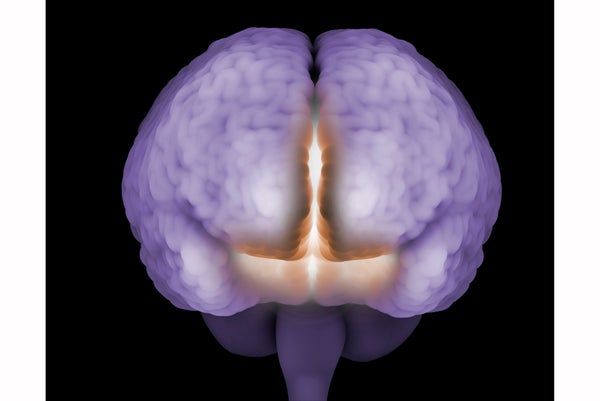The human brain frequently undergoes changes in acidity, with spikes from time to time. One main cause of these temporary surges is carbon dioxide gas, which is constantly released as the brain breaks down sugar to generate energy. Yet the overall chemistry in a healthy brain remains relatively neutral because processes such as respiration—which expels carbon dioxide—help to maintain the status quo. As a result, fleeting acid-base fluctuations usually go unnoticed.
But a growing body of research suggests that for some people, even slight changes in this balance may be linked with panic disorder and other psychiatric conditions. Recent findings provide further evidence that such links are real—and suggest they may extend to schizophrenia and bipolar disorder.
There were earlier hints of the acid-disorder link: studies that directly measured pH—a metric of how acidic or basic something is—in dozens of postmortem human brains revealed lower pH (higher acidity) in patients with schizophrenia and bipolar disorder. Multiple studies in the past few decades have found that when people with panic disorder are exposed to air with a higher than normal concentration of carbon dioxide—which can combine with water in the body to form carbonic acid—they are more likely to experience panic attacks than healthy individuals are. Other research has revealed that the brains of people with panic disorder produce elevated levels of lactate, an acidic source of fuel that is constantly generated and consumed in the energy-hungry brain.
On supporting science journalism
If you're enjoying this article, consider supporting our award-winning journalism by subscribing. By purchasing a subscription you are helping to ensure the future of impactful stories about the discoveries and ideas shaping our world today.
Yet researchers have continued to puzzle over whether this acidity is truly disorder-related or stems from other factors, such as antipsychotic drug use or a person's physical condition just before death. For example, “if you're dying slowly, there would be a longer period where there's a greater chance that you would have low oxygen levels, and that's going to change your metabolism,” explains William Regenold, a psychiatrist and professor at the University of Maryland. In this situation, he says, the body and brain begin to rely more heavily on an oxygen-independent pathway to produce energy. This can lead to higher than normal lactate levels that subsequently decrease pH.

Credit: Amanda Montañez; Source: “Decreased Brain PH as a Shared Endophenotype of Psychiatric Disorders,” by Hideo Hagihara et al., in Neuropsychopharmacology. Published online September 6, 2017
Such questions prompted Tsuyoshi Miyakawa, a neuroscientist at Fujita Health University in Japan, and his colleagues to scour 10 existing data sets from the postmortem brains of more than 400 patients with either schizophrenia or bipolar disorder. Their aim was to test each of the leading theories about the acid-disorder connection.
First, the researchers controlled for potential confounding factors such as a history of antipsychotic medication use and age at death. As they had suspected, brain pH levels in people with schizophrenia and bipolar disorder were significantly lower than in healthy individuals. The team also examined five mouse models—rodents with mutations in genes associated with these conditions—and found similar results: The pH levels in the brains of about two dozen drug-free mice were consistently lower, and their lactate levels higher, than those in comparable healthy animals. What is more, the researchers had euthanized all the mice in the same way—which suggests the pH differences cannot all be explained by how long it takes to die.
These findings, published this fall in Neuropsychopharmacology, collectively provide the most convincing evidence to date that the link between brain acidity and psychiatric disorders is real, Miyakawa says. Regenold, who was not involved in the new work, agrees. “When you combine all these [data sets] and you find strong statistical significance, that's when it becomes more convincing that [lower pH] would be inherent to the disorders,” he says. “I think what is novel about this [study] is that they are singling out lower pH and saying that this is something that—in and of itself—could well be part of the pathophysiology of these disorders, irrespective of what's causing it.”
But John Wemmie, a neuroscientist at the University of Iowa, says that although the postmortem findings are intriguing, it is hard to know if they are related to the pH changes in the living brain. Live brain-imaging studies of people with bipolar disorder, schizophrenia and panic disorder provide much more direct evidence for the acidity hypothesis, he notes. Using magnetic resonance spectroscopy, a method that can detect biochemical changes in tissue, scientists have consistently found elevated levels of lactate in these individuals’ brains.
Even as it becomes clearer that brain acidity may be a key characteristic of schizophrenia and bipolar disorder, whether this could be a cause or effect remains an open question. According to Miyakawa, one possibility is that the increased acidity results from higher than normal neuronal activity in the brains of people with these disorders. Another popular theory is that the greater acidity could be the result of impairments in mitochondria, the powerhouses of cells, Regenold says. These two hypotheses may not be mutually exclusive.
The next big question will be whether low pH in the brain can lead to the cognitive or behavioral changes associated with these disorders, Miyakawa says. There are suggestions that this is the case. “We know that receptors [that are activated by acid] have prominent effects on behavior in animals,” Wemmie says. “That implies that there may be changes in brain pH in the awake and functioning brain that people haven't appreciated all that well.”
